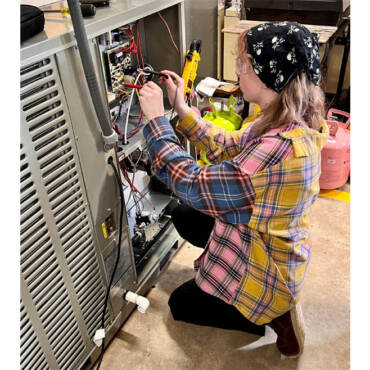With the coronavirus pandemic and a sales boom receding in the rearview mirror, HVACR distributors are facing a normalization that’s bringing opportunities as well as new challenges.
That’s how Tim Fisher, director of market intelligence at Heating, Air-conditioning and Refrigeration Distributors International (HARDI), summarized the current business environment for HVACR distributors as he spoke to a roomful of distribution and manufacturing professionals during HARDI’s September Focus conference in Dallas, Texas.
“We’re just now in this world where the ripples in the pond are kind of going away,” Fisher said during his Voice of the Distributor presentation. “Everything that caused this ridiculous environment you’ve been working in the last couple of years is finally dissipated, and we’re in a place now where you can actually start to think about business in a more pragmatic, practical, strategic way.”
However, that doesn’t mean the path is smooth. Higher costs and lower sales-growth rates are compressing margins, Fisher said, and at a time when distributors’ inventory remains high, the transition to lower-GWP refrigerants is complicating decisions about inventory.
Fisher based his snapshot of the HVACR distribution market on data and the results of a survey earlier this year of about 80 distribution businesses, plus interviews with between 15 and 20 HVACR distribution executives from around the country.
Until recently, Fisher said, distributors were seeing annual sales growth of more than 9%.
“You’ve seen just under 9½% growth annually from 2018 through the end of this past year within distribution,” he said. “Two-thirds of HVAC, our contractor purchases, currently flow through that channel. But the key point here: The dynamics of this market are shifting.”
The pandemic initially brought “real demand growth,” Fisher said, driven by the work-from-home trend. But by the second half of 2021 and early 2022, he added, demand was dropping, yet higher prices supported continued revenue growth for a while.
Now, Fisher said, annual sales growth is around 3%.
The pandemic-related demand, he added, was accompanied by shifts in the proportion of revenue that came from different categories of products. Whereas a 10-year trend showed that HVAC and refrigeration equipment sales typically made up about 55% of distributors’ revenue, with controls, parts, plumbing, and hydronics making up the rest, that proportion jumped to around 65% in 2021 and 2022, he said. That number, Fisher said, has started to come down.
“That’s a trend that’s going to continue, OK?” he said. “It’s going to steadily move back closer and closer to that pre-COVID mean of about 55%,” with supplies representing an increasing share of revenue.
That change, Fisher said, indicates a growing repair-over-replace tendency among consumers.
“As one piece of the pie shrinks, another piece has to grow, and that’s where we’re seeing the growth,” he said.
The boom period, Fisher said, brought spikes in gross profit margins, as high as 31%, with a median at the peak of about 28%. Those margins are now trending down toward a more normal median of about 24% or 25%, he said.
“On the periphery, you’re going to find those that are challenged even more, though, because of how costs have evolved through the pandemic,” Fisher said. “All of this is going to affect profitability. … It’s all squeezing distributors in a way that is going to lead to some tough decision-making down the road.”
Complicating the picture, Fisher said, is that inventory levels are higher than distributors would like, a function of the pandemic-era boom.
“What happens when you have an environment of inflation, high sales growth, and then sales dissipate: The tide goes out; you’re left with kind of that residual,” he said.
More than half the distributors surveyed, Fisher said, reported having reduced “safety stock” levels in 2024 compared to what they held in recent years. But some of those who’d decreased that inventory, as well as some of those who’d boosted it, he added, mentioned the refrigerant transition as a “confounding factor” in their inventory decisions.
From the point of view of a distributor, Fisher described it this way: “‘Yeah, we’ve decreased our safety stock, but guess what? This looming change here means we’re going to have to boost it. We’re going to have to lift our inventory levels a bit from where we’d like them to be.’”
“You get the picture here,” Fisher added later. “Lots of factors compressing margins along the pricing line.”
Whether you require installation, repair, or maintenance, our technicians will assist you with top-quality service at any time of the day or night. Take comfort in knowing your indoor air quality is the best it can be with MOE heating & cooling services Ontario's solution for heating, air conditioning, and ventilation that’s cooler than the rest.
Contact us to schedule a visit. Our qualified team of technicians, are always ready to help you and guide you for heating and cooling issues. Weather you want to replace an old furnace or install a brand new air conditioner, we are here to help you. Our main office is at Kitchener but we can service most of Ontario's cities
Source link



